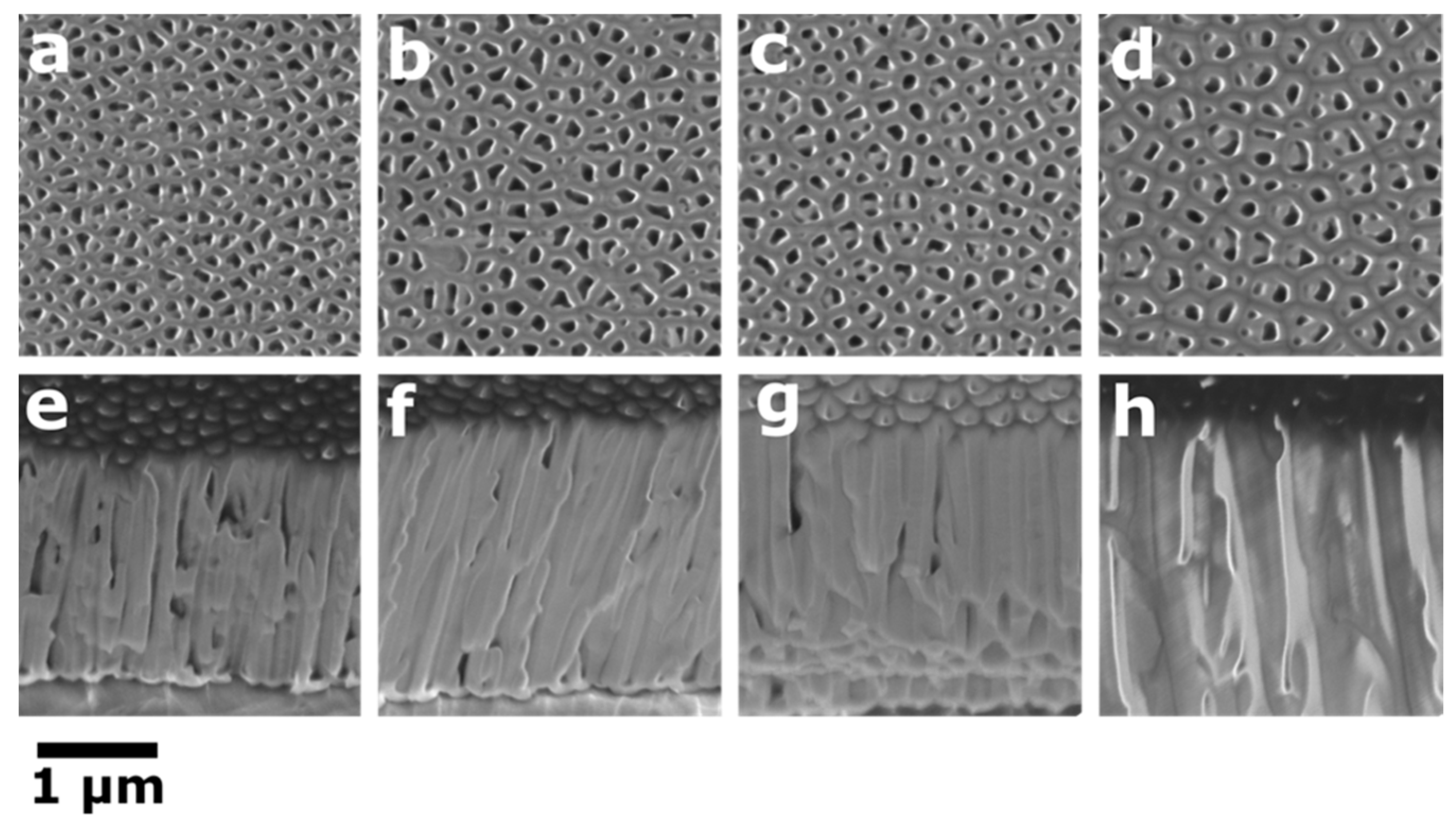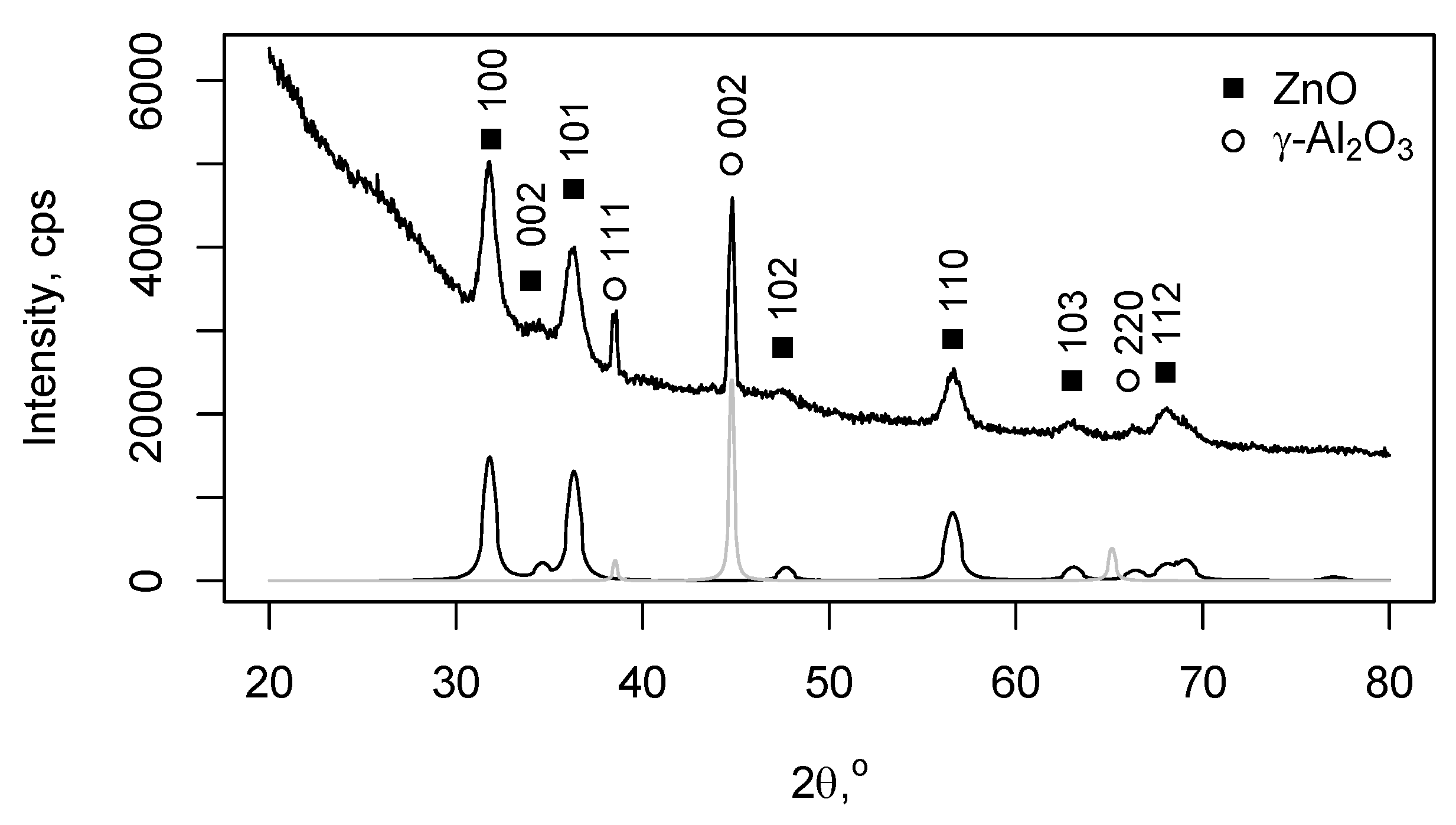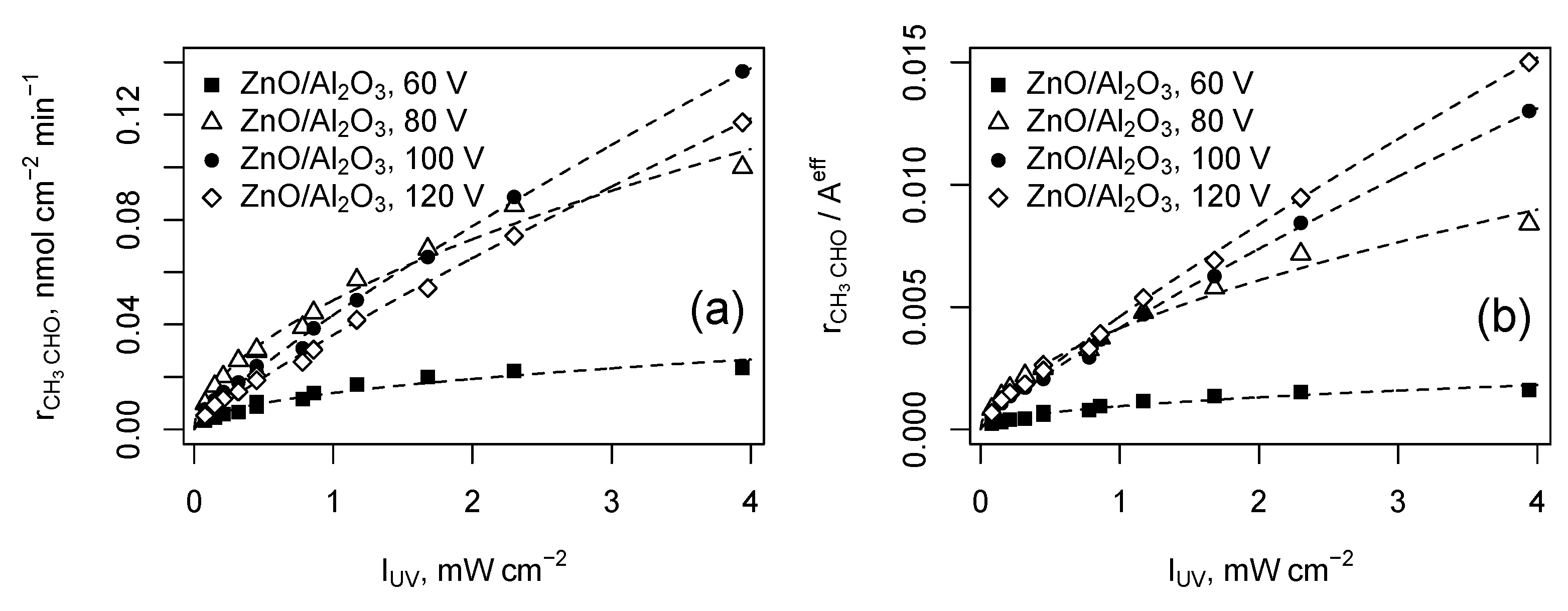Effects of Anodic Aluminum Oxide Substrate Pore Geometry on the Gas-Phase Photocatalytic Activity of ZnO/Al2O3 Composites Prepared by Atomic Layer Deposition
Abstract
:1. Introduction
2. Materials and Methods
2.1. Preparation of AAO Substrates
2.2. ALD Deposition of ZnO
2.3. Characterization of ZnO/Al2O3 Composites
2.4. Photocatalytic Experiments
3. Results and Discussion
3.1. Characterization of ZnO/Al2O3
3.2. Photocatalytic Activity
4. Conclusions
Author Contributions
Funding
Institutional Review Board Statement
Informed Consent Statement
Data Availability Statement
Acknowledgments
Conflicts of Interest
References
- Md Jani, A.M.; Habiballah, A.S.; Budiman Abdul Halim, M.Z.; Ahmad Zulkifli, F.W.; Mahmud, A.H.; Yazid, H. Nanoporous Anodic Aluminum Oxide (NAAO) for Catalytic, Biosensing and Template Synthesis Applications (A Review). Curr. Nanosci. 2018, 15, 49–63. [Google Scholar] [CrossRef]
- Tzaneva, B.; Naydenov, A.; Todorova, S.; Videkov, V.; Milusheva, V.; Stefanov, P. Cobalt electrodeposition in nanoporous anodic aluminium oxide for application as catalyst for methane combustion. Electrochim. Acta 2016, 191, 192–199. [Google Scholar] [CrossRef]
- Ali, H.O. Review of porous anodic aluminium oxide (AAO) applications for sensors, MEMS and biomedical devices. Trans. IMF 2017, 95, 290–296. [Google Scholar] [CrossRef]
- Takayama, O.; Cada, M. Two-dimensional metallo-dielectric photonic crystals embedded in anodic porous alumina for optical wavelengths. Appl. Phys. Lett. 2004, 85, 1311–1313. [Google Scholar] [CrossRef] [Green Version]
- Białek, E.; Włodarski, M.; Norek, M. Influence of Anodization Temperature on Geometrical and Optical Properties of Porous Anodic Alumina (PAA)-Based Photonic Structures. Materials 2020, 13, 3185. [Google Scholar] [CrossRef] [PubMed]
- Lim, S.Y.; Law, C.S.; Marković, M.; Kirby, J.K.; Abell, A.D.; Santos, A. Engineering the Slow Photon Effect in Photoactive Nanoporous Anodic Alumina Gradient-Index Filters for Photocatalysis. ACS Appl. Mater. Interfaces 2018, 10, 24124–24136. [Google Scholar] [CrossRef] [Green Version]
- Berger, T.; Regmi, C.; Schäfer, A.; Richards, B. Photocatalytic degradation of organic dye via atomic layer deposited TiO2 on ceramic membranes in single-pass flow-through operation. J. Membr. Sci. 2020, 604, 118015. [Google Scholar] [CrossRef]
- Kure-Chu, S.-Z.; Inoue, S.; Wada, K.; Li, D.; Haneda, H. Highly porous TiO2/Al2O3 composite nanostructures on glass by anodization and the sol–gel process: Fabrication and photocatalytic characteristics. J. Mater. Chem. 2003, 13, 866–870. [Google Scholar] [CrossRef]
- Zhao, H.; Liu, L.; Lei, Y. A mini review: Functional nanostructuring with perfectly-ordered anodic aluminum oxide template for energy conversion and storage. Front. Chem. Sci. Eng. 2018, 12, 481–493. [Google Scholar] [CrossRef]
- Blagoev, B.S.; Vlakhov, E.; Videkov, V.; Tzaneva, B.; Łuka, G.; Witkowski, B.; Terziyska, P.; Leclercq, J.; Krajewski, T.; Guziewicz, E.; et al. Atomic layer deposition of ZnO: Al on PAA substrates. J. Phys. Conf. Ser. 2016, 764, 012004. [Google Scholar] [CrossRef]
- Schindelin, J.; Arganda-Carreras, I.; Frise, E.; Kaynig, V.; Longair, M.; Pietzsch, T.; Preibisch, S.; Rueden, C.; Saalfeld, S.; Schmid, B.; et al. Fiji: An open-source platform for biological-image analysis. Nat. Chem. Biol. 2012, 9, 676–682. [Google Scholar] [CrossRef] [Green Version]
- Kraus, W.; Nolze, G. POWDER CELL—A program for the representation and manipulation of crystal structures and calculation of the resulting X-ray powder patterns. J. Appl. Crystallogr. 1996, 29, 301–303. [Google Scholar] [CrossRef]
- Dollase, W.A. Correction of intensities for preferred orientation in powder diffractometry: Application of the March model. J. Appl. Crystallogr. 1986, 19, 267–272. [Google Scholar] [CrossRef]
- Stefanov, B.; Niklasson, G.; Granqvist, C.; Österlund, L. Gas-phase photocatalytic activity of sputter-deposited anatase TiO2 films: Effect of <001> preferential orientation, surface temperature and humidity. J. Catal. 2016, 335, 187–196. [Google Scholar] [CrossRef] [Green Version]
- Domagalski, J.; Xifre-Perez, E.; Marsal, L. Recent Advances in Nanoporous Anodic Alumina: Principles, Engineering, and Applications. Nanomaterials 2021, 11, 430. [Google Scholar] [CrossRef] [PubMed]
- Jedrzejewska-Szczerska, M.; Wierzba, P.; Chaaya, A.A.; Bechelany, M.; Miele, P.; Viter, R.; Mazikowski, A.; Karpienko, K.; Wróbel, M. ALD thin ZnO layer as an active medium in a fiber-optic Fabry–Perot interferometer. Sens. Actuators A Phys. 2015, 221, 88–94. [Google Scholar] [CrossRef]
- Chaaya, A.A.; Viter, R.; Baleviciute, I.; Bechelany, M.; Ramanavicius, A.; Gertnere, Z.; Erts, D.; Smyntyna, V.; Miele, P. Tuning Optical Properties of Al2O3/ZnO Nanolaminates Synthesized by Atomic Layer Deposition. J. Phys. Chem. C 2014, 118, 3811–3819. [Google Scholar] [CrossRef]
- Baek, S.-H.; Lee, H.-J.; Lee, S.-N. Thickness dependence of crystal and optical characterization on ZnO thin film grown by atomic layer deposition. AIP Adv. 2018, 8, 065306. [Google Scholar] [CrossRef]
- Mills, A.; Wang, J.; Ollis, D.F. Kinetics of Liquid Phase Semiconductor Photoassisted Reactions: Supporting Observations for a Pseudo-Steady-State Model. J. Phys. Chem. B 2006, 110, 14386–14390. [Google Scholar] [CrossRef] [PubMed] [Green Version]
- Huang, J.; Lin, C.-J.; Lai, Y.-K.; Sun, L.; Li, J. Some Critical Structure Factors of Titanium Oxide Nanotube Array in Its Photocatalytic Activity. Environ. Sci. Technol. 2007, 41, 4735–4740. [Google Scholar] [CrossRef]
- Liu, B.; Nakata, K.; Liu, S.; Sakai, M.; Ochiai, T.; Murakami, T.; Takagi, K.; Fujishima, A. Theoretical Kinetic Analysis of Heterogeneous Photocatalysis by TiO2 Nanotube Arrays: The Effects of Nanotube Geometry on Photocatalytic Activity. J. Phys. Chem. C 2012, 116, 7471–7479. [Google Scholar] [CrossRef]
- Libbrecht, W.; Vandaele, K.; De Buysser, K.; Verberckmoes, A.; Thybaut, J.W.; Poelman, H.; De Clercq, J.; Van Der Voort, P. Tuning the Pore Geometry of Ordered Mesoporous Carbons for Enhanced Adsorption of Bisphenol-A. Materials 2015, 8, 1652–1665. [Google Scholar] [CrossRef] [PubMed]






| Anodization Voltage (V) | 60 | 80 | 100 | 120 |
|---|---|---|---|---|
| Pore diameter (nm) | 93 ± 20 | 115 ± 20 | 130 ± 20 | 134 ± 23 |
| Interpore distance (nm) | 185 ± 31 | 227 ± 32 | 228 ± 29 | 286 ± 42 |
| Geometric-to-effective surface area conversion factor (Aeff) | 14.7 | 11.9 | 10.5 | 7.8 |
| (eV) | 3.247 | 3.238 | 3.251 | 3.253 |
| (mW cm−2) | CH3CHO PCO rate, r (nmol cm−2 min−1) | |||
| 0.08 | 0.0034 | 0.0098 | 0.0077 | 0.0053 |
| 0.15 | 0.0044 | 0.0164 | 0.0112 | 0.0093 |
| 0.21 | 0.0059 | 0.0201 | 0.0143 | 0.0116 |
| 0.32 | 0.0065 | 0.0262 | 0.0179 | 0.0144 |
| 0.45 | 0.0087 | 0.0305 | 0.0217 | 0.0187 |
| 0.78 | 0.0114 | 0.0389 | 0.0309 | 0.0258 |
| 0.86 | 0.0138 | 0.0445 | 0.0386 | 0.0304 |
| 1.17 | 0.0171 | 0.0570 | 0.0494 | 0.0418 |
| 1.68 | 0.0200 | 0.0689 | 0.0657 | 0.0539 |
| 2.30 | 0.0224 | 0.0854 | 0.0886 | 0.0738 |
| 3.94 | 0.0236 | 0.0999 | 0.1366 | 0.1171 |
| Results from Equation (6) fit: | ||||
| UV-independent rate () | 0.0139 | 0.0492 | 0.0436 | 0.0360 |
| Reaction order () | 0.47 | 0.56 | 0.83 | 0.86 |
| Residual standard error | 0.0017 | 0.0034 | 0.0020 | 0.0018 |
Publisher’s Note: MDPI stays neutral with regard to jurisdictional claims in published maps and institutional affiliations. |
© 2021 by the authors. Licensee MDPI, Basel, Switzerland. This article is an open access article distributed under the terms and conditions of the Creative Commons Attribution (CC BY) license (https://creativecommons.org/licenses/by/4.0/).
Share and Cite
Stefanov, B.I.; Blagoev, B.S.; Österlund, L.; Tzaneva, B.R.; Angelov, G.V. Effects of Anodic Aluminum Oxide Substrate Pore Geometry on the Gas-Phase Photocatalytic Activity of ZnO/Al2O3 Composites Prepared by Atomic Layer Deposition. Symmetry 2021, 13, 1456. https://doi.org/10.3390/sym13081456
Stefanov BI, Blagoev BS, Österlund L, Tzaneva BR, Angelov GV. Effects of Anodic Aluminum Oxide Substrate Pore Geometry on the Gas-Phase Photocatalytic Activity of ZnO/Al2O3 Composites Prepared by Atomic Layer Deposition. Symmetry. 2021; 13(8):1456. https://doi.org/10.3390/sym13081456
Chicago/Turabian StyleStefanov, Bozhidar I., Blagoy S. Blagoev, Lars Österlund, Boriana R. Tzaneva, and George V. Angelov. 2021. "Effects of Anodic Aluminum Oxide Substrate Pore Geometry on the Gas-Phase Photocatalytic Activity of ZnO/Al2O3 Composites Prepared by Atomic Layer Deposition" Symmetry 13, no. 8: 1456. https://doi.org/10.3390/sym13081456






